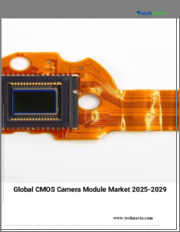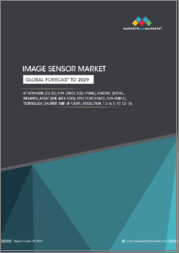
|
시장보고서
상품코드
1663022
유기 CMOS 이미지 센서 시장 규모, 점유율, 성장 분석, 영상 처리별, 배열 유형별, 용도별, 산업 분야별, 지역별 - 산업 예측(2025-2032년)Organic CMOS Image Sensor Market Size, Share, and Growth Analysis, By Image Processing (2D Sensor, 3D Sensor), By Array Type (Linear Image Sensors, Area Image Sensors), By Applications, By Industry Vertical, By Region - Industry Forecast 2025-2032 |
||||||
유기 CMOS 이미지 센서 2023년 시장 규모는 16억 9,000만 달러로 평가되었고, 2024년 19억 달러에서 2032년에는 48억 4,000만 달러로 성장할 것으로 예상되며, 예측 기간(2025-2032년) 동안 12.4%의 연평균 복합 성장률(CAGR)을 보일 전망입니다.
다양한 분야에서 고성능 이미징 솔루션에 대한 수요가 증가함에 따라 유기 CMOS 이미지 센서의 매출이 크게 증가할 것으로 예상됩니다. 이 센서는 저전력 소비, 경량 설계, 우수한 광 감도로 인해 스마트폰 카메라, 의료용 이미징, 감시 카메라, 차량용 카메라 등의 용도에 적합합니다. 전자제품에서 지속가능성이 우선순위로 떠오르면서 친환경 제품에 대한 수요가 증가함에 따라 유기 CMOS 센서 시장은 더욱 확대될 것으로 예상됩니다. 또한, 유기 반도체 기술의 발전은 향후 시장 성장에 매우 중요합니다. 특히 스마트폰 분야에서는 컴팩트한 디자인에 높은 성능과 에너지 효율을 겸비한 이미지 센서가 널리 채택되고 있어, 신규 진입업체와 기존 진입업체 모두에게 유망한 시장 기회를 제공합니다.
목차
서론
- 조사 목적
- 조사 범위
- 정의
조사 방법
- 정보 조달
- 2차와 1차 데이터 방법
- 시장 규모 예측
- 시장 전제조건과 제한
주요 요약
- 세계 시장 전망
- 공급과 수요 동향 분석
- 부문별 기회 분석
시장 역학과 전망
- 시장 개요
- 시장 규모
- 시장 역학
- 성장 촉진요인과 기회
- 성장 억제요인과 과제
- Porter의 Five Forces 분석
주요 시장 인사이트
- 중요 성공 요인
- 경쟁 정도
- 주요 투자 기회
- 시장 생태계
- 시장의 매력 지수(2024년)
- PESTEL 분석
- 거시경제 지표
- 밸류체인 분석
- 가격 분석
유기 CMOS 이미지 센서 시장 규모 : 영상 처리별
- 시장 개요
- 2D 센서
- 3D 센서
유기 CMOS 이미지 센서 시장 규모 : 배열 유형별
- 시장 개요
- 선형 이미지 센서
- 에어리어 이미지 센서
유기 CMOS 이미지 센서 시장 규모 : 용도별
- 시장 개요
- 3D 이미징
- 비디오
- 머신 비전
- 생체인식
- 기타
유기 CMOS 이미지 센서 시장 규모 : 산업 분야별
- 시장 개요
- 가전
- 자동차
- 의료 및 생명과학
- 보안 및 감시
- 로봇 공학
- 기타
유기 CMOS 이미지 센서 시장 규모
- 북미
- 미국
- 캐나다
- 유럽
- 독일
- 스페인
- 프랑스
- 영국
- 이탈리아
- 기타 유럽
- 아시아태평양
- 중국
- 인도
- 일본
- 한국
- 기타 아시아태평양
- 라틴아메리카
- 브라질
- 기타 라틴아메리카
- 중동 및 아프리카
- GCC 국가
- 남아프리카공화국
- 기타 중동 및 아프리카
경쟁 정보
- 주요 5개사 비교
- 주요 기업의 시장 포지셔닝(2024년)
- 주요 시장 기업이 채택한 전략
- 최근 시장 동향
- 기업의 시장 점유율 분석(2024년)
- 주요 기업 개요
- 기업 상세
- 제품 포트폴리오 분석
- 기업 부문별 점유율 분석
- 전년대비 매출 비교(2022-2024년)
주요 기업 개요
- Sony Corporation(Japan)
- Samsung Electronics Co., Ltd.(South Korea)
- ON Semiconductor Corporation(United States)
- STMicroelectronics N.V.(Switzerland)
- Canon Inc.(Japan)
- SK Hynix Inc.(South Korea)
- Teledyne Technologies Incorporated(United States)
- Panasonic Holdings Corporation(Japan)
- Himax Technologies, Inc.(Taiwan)
- GalaxyCore Shanghai Limited Corporation(China)
- AMS-Osram AG(Austria)
- Analog Devices, Inc.(United States)
- Tower Semiconductor Ltd.(Israel)
- Brillnics Japan Inc.(Japan)
- Anitoa Systems, LLC(United States)
- PixArt Imaging Inc.(Taiwan)
- Hamamatsu Photonics K.K.(Japan)
- BAE Systems plc(United Kingdom)
- Galaxycore Microelectronics(China)
- ANDANTA GmbH(Germany)
결론과 제안
LSH 25.03.31Organic CMOS Image Sensor Market size was valued at USD 1.69 billion in 2023 and is poised to grow from USD 1.9 billion in 2024 to USD 4.84 billion by 2032, growing at a CAGR of 12.4% during the forecast period (2025-2032).
The rising demand for high-performance imaging solutions across multiple sectors is set to significantly boost sales of organic CMOS image sensors. These sensors are favored for their low power consumption, lightweight design, and superior light sensitivity, making them ideal for applications in smartphone cameras, medical imaging, surveillance, and automotive cameras. As sustainability becomes a priority in electronics, the demand for eco-friendly products is expected to further enhance the market for organic CMOS sensors. Furthermore, advancements in organic semiconductor technology will be pivotal for future market growth. The widespread adoption of image sensors that combine enhanced performance with energy efficiency in compact designs, particularly in the smartphone sector, presents promising opportunities for both new and established market players.
Top-down and bottom-up approaches were used to estimate and validate the size of the Organic CMOS Image Sensor market and to estimate the size of various other dependent submarkets. The research methodology used to estimate the market size includes the following details: The key players in the market were identified through secondary research, and their market shares in the respective regions were determined through primary and secondary research. This entire procedure includes the study of the annual and financial reports of the top market players and extensive interviews for key insights from industry leaders such as CEOs, VPs, directors, and marketing executives. All percentage shares split, and breakdowns were determined using secondary sources and verified through Primary sources. All possible parameters that affect the markets covered in this research study have been accounted for, viewed in extensive detail, verified through primary research, and analyzed to get the final quantitative and qualitative data.
Organic CMOS Image Sensor Market Segments Analysis
Global Organic CMOS Image Sensor Market is segmented by Image Processing, Array Type, Applications, Industry Vertical and region. Based on Image Processing, the market is segmented into 2D Sensor and 3D Sensor. Based on Array Type, the market is segmented into Linear Image Sensors and Area Image Sensors. Based on Applications, the market is segmented into 3D Imaging, Video, Machine Vision, Biometrics and Others. Based on Industry Vertical, the market is segmented into Consumer Electronics, Automotive, Medical and Life Sciences, Security and Surveillance, Robotics and Others. Based on region, the market is segmented into North America, Europe, Asia Pacific, Latin America and Middle East & Africa.
Driver of the Organic CMOS Image Sensor Market
The Organic CMOS Image Sensor market is experiencing significant growth fueled by the escalating demand for smartphone cameras. The surge in smartphone sales over recent years has created a substantial market for these advanced imaging technologies. As consumers increasingly seek better camera quality for their devices, the advantages of organic CMOS image sensors-such as enhanced image quality, lower power consumption, and superior sensitivity-are becoming more recognized. This growing awareness, combined with the smartphone industry's expansion, is likely to propel the demand for organic CMOS image sensors, making them a crucial component in the future of mobile photography.
Restraints in the Organic CMOS Image Sensor Market
The Organic CMOS Image Sensor market faces significant constraints due to limited market penetration. Traditional silicon-based sensors have long been established and are generally more cost-effective and efficient than organic alternatives in most aspects. As a result, the adoption of organic CMOS image sensors remains relatively low, which is expected to hinder market growth in the long term. This reluctance to shift from established silicon technology poses a challenge for the organic sector, making it difficult to achieve widespread acceptance and ultimately limiting the potential expansion of the Organic CMOS Image Sensor market.
Market Trends of the Organic CMOS Image Sensor Market
The Organic CMOS Image Sensor market is experiencing a notable surge driven by the growing demand for advanced low-light imaging solutions. As consumers and industries alike seek enhanced night vision capabilities-particularly in applications ranging from smartphone cameras to security systems-the organic CMOS technology's superior low-light performance positions it as a key player. This trend is further fueled by innovations in imaging technology, enabling clearer, more detailed images in challenging lighting conditions. Consequently, organizations specializing in organic CMOS sensors are poised to leverage this demand, unlocking new avenues for growth and establishing their dominance in the competitive imaging market landscape.
Table of Contents
Introduction
- Objectives of the Study
- Scope of the Report
- Definitions
Research Methodology
- Information Procurement
- Secondary & Primary Data Methods
- Market Size Estimation
- Market Assumptions & Limitations
Executive Summary
- Global Market Outlook
- Supply & Demand Trend Analysis
- Segmental Opportunity Analysis
Market Dynamics & Outlook
- Market Overview
- Market Size
- Market Dynamics
- Drivers & Opportunities
- Restraints & Challenges
- Porters Analysis
- Competitive rivalry
- Threat of substitute
- Bargaining power of buyers
- Threat of new entrants
- Bargaining power of suppliers
Key Market Insights
- Key Success Factors
- Degree of Competition
- Top Investment Pockets
- Market Ecosystem
- Market Attractiveness Index, 2024
- PESTEL Analysis
- Macro-Economic Indicators
- Value Chain Analysis
- Pricing Analysis
Global Organic CMOS Image Sensor Market Size by Image Processing & CAGR (2025-2032)
- Market Overview
- 2D Sensor
- 3D Sensor
Global Organic CMOS Image Sensor Market Size by Array Type & CAGR (2025-2032)
- Market Overview
- Linear Image Sensors
- Area Image Sensors
Global Organic CMOS Image Sensor Market Size by Applications & CAGR (2025-2032)
- Market Overview
- 3D Imaging
- Video
- Machine Vision
- Biometrics
- Others
Global Organic CMOS Image Sensor Market Size by Industry Vertical & CAGR (2025-2032)
- Market Overview
- Consumer Electronics
- Automotive
- Medical and Life Sciences
- Security and Surveillance
- Robotics
- Others
Global Organic CMOS Image Sensor Market Size & CAGR (2025-2032)
- North America (Image Processing, Array Type, Applications, Industry Vertical)
- US
- Canada
- Europe (Image Processing, Array Type, Applications, Industry Vertical)
- Germany
- Spain
- France
- UK
- Italy
- Rest of Europe
- Asia Pacific (Image Processing, Array Type, Applications, Industry Vertical)
- China
- India
- Japan
- South Korea
- Rest of Asia-Pacific
- Latin America (Image Processing, Array Type, Applications, Industry Vertical)
- Brazil
- Rest of Latin America
- Middle East & Africa (Image Processing, Array Type, Applications, Industry Vertical)
- GCC Countries
- South Africa
- Rest of Middle East & Africa
Competitive Intelligence
- Top 5 Player Comparison
- Market Positioning of Key Players, 2024
- Strategies Adopted by Key Market Players
- Recent Developments in the Market
- Company Market Share Analysis, 2024
- Company Profiles of All Key Players
- Company Details
- Product Portfolio Analysis
- Company's Segmental Share Analysis
- Revenue Y-O-Y Comparison (2022-2024)
Key Company Profiles
- Sony Corporation (Japan)
- Company Overview
- Business Segment Overview
- Financial Updates
- Key Developments
- Samsung Electronics Co., Ltd. (South Korea)
- Company Overview
- Business Segment Overview
- Financial Updates
- Key Developments
- ON Semiconductor Corporation (United States)
- Company Overview
- Business Segment Overview
- Financial Updates
- Key Developments
- STMicroelectronics N.V. (Switzerland)
- Company Overview
- Business Segment Overview
- Financial Updates
- Key Developments
- Canon Inc. (Japan)
- Company Overview
- Business Segment Overview
- Financial Updates
- Key Developments
- SK Hynix Inc. (South Korea)
- Company Overview
- Business Segment Overview
- Financial Updates
- Key Developments
- Teledyne Technologies Incorporated (United States)
- Company Overview
- Business Segment Overview
- Financial Updates
- Key Developments
- Panasonic Holdings Corporation (Japan)
- Company Overview
- Business Segment Overview
- Financial Updates
- Key Developments
- Himax Technologies, Inc. (Taiwan)
- Company Overview
- Business Segment Overview
- Financial Updates
- Key Developments
- GalaxyCore Shanghai Limited Corporation (China)
- Company Overview
- Business Segment Overview
- Financial Updates
- Key Developments
- AMS-Osram AG (Austria)
- Company Overview
- Business Segment Overview
- Financial Updates
- Key Developments
- Analog Devices, Inc. (United States)
- Company Overview
- Business Segment Overview
- Financial Updates
- Key Developments
- Tower Semiconductor Ltd. (Israel)
- Company Overview
- Business Segment Overview
- Financial Updates
- Key Developments
- Brillnics Japan Inc. (Japan)
- Company Overview
- Business Segment Overview
- Financial Updates
- Key Developments
- Anitoa Systems, LLC (United States)
- Company Overview
- Business Segment Overview
- Financial Updates
- Key Developments
- PixArt Imaging Inc. (Taiwan)
- Company Overview
- Business Segment Overview
- Financial Updates
- Key Developments
- Hamamatsu Photonics K.K. (Japan)
- Company Overview
- Business Segment Overview
- Financial Updates
- Key Developments
- BAE Systems plc (United Kingdom)
- Company Overview
- Business Segment Overview
- Financial Updates
- Key Developments
- Galaxycore Microelectronics (China)
- Company Overview
- Business Segment Overview
- Financial Updates
- Key Developments
- ANDANTA GmbH (Germany)
- Company Overview
- Business Segment Overview
- Financial Updates
- Key Developments



















